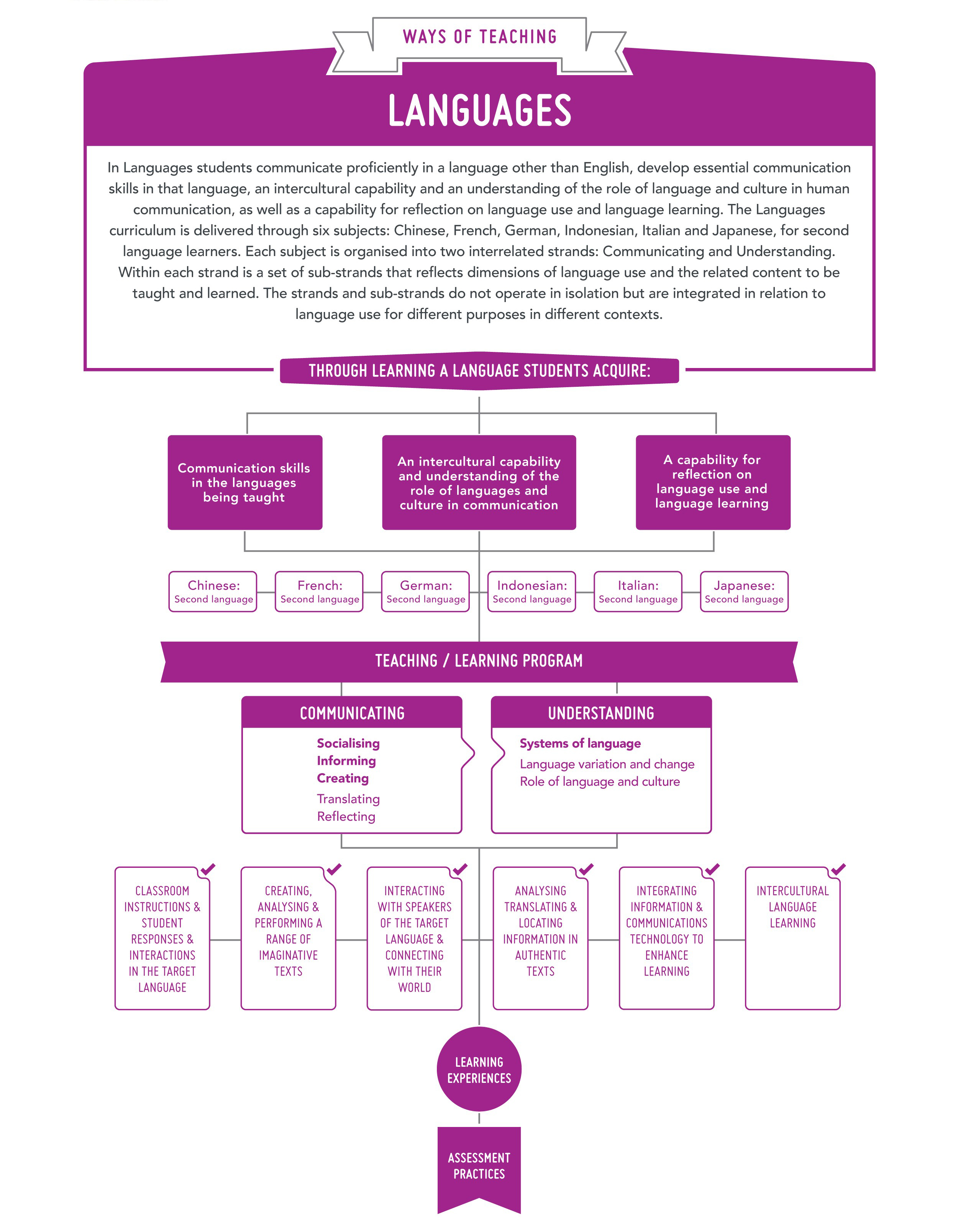Ways of Teaching
The ‘ways of teaching’ aim to support teachers with planning for curriculum delivery across the years of school, with the teaching in each year extending learning in previous years.
The ‘ways of teaching’ complement the principles of teaching and learning in the Western Australian Curriculum and Assessment Outline (http://k10outline.scsa.wa.edu.au/). The principles focus on the provision of a school and class environment that is intellectually, socially and physically supportive of learning. The principles assist whole-school planning and individual classroom practice.
The Languages learning area is made up of six distinct subjects: Chinese: Second Language, French: Second Language, German: Second Language, Indonesian: Second Language, Italian: Second Language and Japanese: Second Language. The content is presented through two interrelated strands Communicating and Understanding. The Communicating strand focuses on students learning to use the target language to interpret, create and exchange meaning and to use the language to communicate in different contexts while the Understanding strand focuses on students analysing and understanding language and culture as resources for interpreting and shaping meaning in intercultural exchange.
Through learning a language students learn to effectively communicate in the second language they are learning, develop an intercultural capability and understanding of the role of language and culture in communication and reflect on their language use and language learning.
Languages
In Languages students learn to communicate across the five sub strands of Socialising, Informing, Creating, Translating and Reflecting. Students analyse and develop their understanding of language and culture through the three sub strands of Systems of language, Language variation and change and the Role of language and culture. The sub strands are designed to be taught in an integrated way with the aim that they enrich the capability of the students to become successful intercultural communicators. The strands and sub strands do not operate in isolation but are integrated in relation to language use for different purposes in different contexts. The relative contribution of each strand will differ for different languages and for different stages of learning.
To support students' learning, teachers should develop teaching and learning programs in Languages to ensure that:
- the prior knowledge of students is identified to establish a starting point for learning
- in the early years, planning includes child-initiated, self-directed and play based activities
- the sub strands within the Communicating and Understanding strands are incorporated and integrated to ensure rich learning experiences
- opportunities are provided for students to communicate in the target language and to reflect on their communication and language learning experiences
- the target language is used as a means of instruction to build the students’ skills in comprehending spoken language.
To engage students in Languages, teachers typically create learning experiences which:
- draw on students’ personal interests, real-life experiences, or use stimulus materials to create meaningful linkages to the places where the target language is spoken
- use a wide range of authentic texts that are in the target language such as websites, tickets, films, advertisements and children’s picture books
- involve students in the performance, analysis and creation of a range of creative and imaginative texts such as poems, plays, songs and stories
- involve students in learning outside the classroom through exposure to authentic experiences and the facilitation of connection points with the local and wider community
- provide opportunities for students to communicate with first language speakers of the language they are learning through written, digital or spoken communication
- use new and emerging technologies to engage students in their language learning and to facilitate communication between first language speakers of the target language
- include current and/or recent events, issues or ‘hot topics’ that are relevant to young people in the country/countries where the target language is spoken.
Figure 1 is a visual representation of ways of teaching Languages.
For information on how to collect evidence to inform planning for ongoing learning experiences in Languages, refer to ‘Ways of Assessing’.

 Languages Assessment Activities Template
Languages Assessment Activities Template